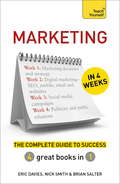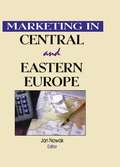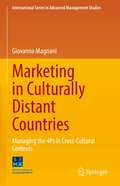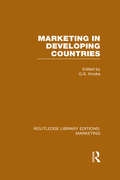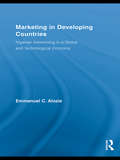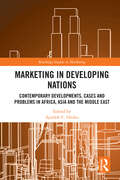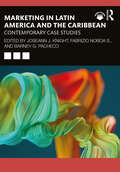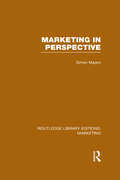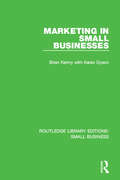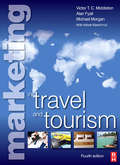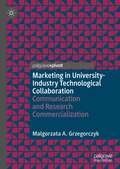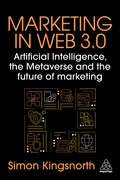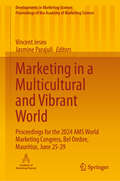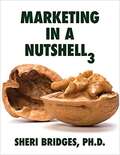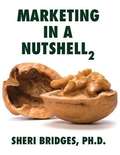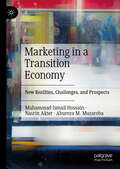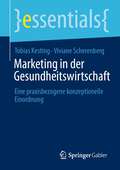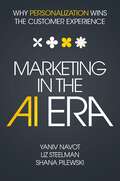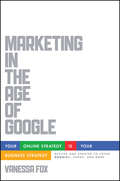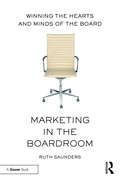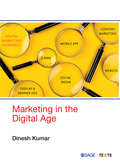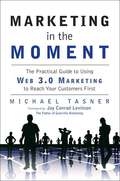- Table View
- List View
Marketing in 4 Weeks: The Complete Guide to Success: Teach Yourself
by Brian Salter Nick Smith Eric DaviesWhatever your degree of prior knowledge, this 28-day course will put you on the path to business success. It includes four tried-and-tested bestselling titles - Successful Marketing in a Week; Successful Digital Marketing in a Week; Successful Social Media Marketing in a Week; Successful Publicity in a Week. Each day of the course is packed with proven and practical advice, and is rounded off by a quiz which helps you ensure you have understood the key areas.
Marketing in 4 Weeks: The Complete Guide to Success: Teach Yourself
by Brian Salter Nick Smith Eric DaviesMarketing In 4 Weeks is a comprehensive guide to contemporary marketing and PR, giving you everything you need to know in one place. Made up of four bestselling books in one, this book delivers a complete course in modern marketing. From strategy, mobile and ecommerce to social media, SEO and PR you'll discover all the tools, techniques and strategies you need to get your marketing right.This book introduces you to the main themes and ideas of marketing, digital marketing and PR, giving you a knowledge and understanding of the key concepts, together with practical and thought-provoking exercises. Whether you choose to work through it like a 4 week course or dip in and out, Marketing In 4 Weeks is your fastest route to success:Week 1: Marketing In A WeekWeek 2: Digital Marketing In A WeekWeek 3: Social Media Marketing In A WeekWeek 4: Public Relations In A WeekABOUT THE SERIESIn A Week books are for managers, leaders, and business executives who want to succeed at work. From negotiating and content marketing to finance and social media, the In A Week series covers the business topics that really matter and that will help you make a difference today. Written in straightforward English, each book is structured as a seven-day course so that with just a little work each day, you will quickly master the subject. In a fast-changing world, this series enables readers not just to get up to speed, but to get ahead.
Marketing in Central and Eastern Europe
by Erdener KaynakSince the sudden opening of the markets in Central and Eastern Europe (CEE) in 1989, there has been a growing need to investigate the fundamental changes occurring in the countries’marketing environment, the lucrative market opportunities created by the changes, and the inscrutable marketing practice followed by local and international companies. Marketing in Central and Eastern Europe helps you understand the changes taking place in these valuable and challenging markets and introduces you to the emerging opportunities and effective marketing strategies to be employed in the region. Researchers specializing in CEE business; managers of international companies operating in or contemplating entering CEE markets; and students studying CEE business, East-West business, or marketing in transitional economies will better understand the region by examining issues of cross- cultural inquiry, commonality, and market segmentation. Marketing in Central and Eastern Europe also provides you with: a region-relevant market analysis to determine environmental dimensions of emerging markets a preliminary report on market-entry strategies in Poland an assessment of foreign direct investment opportunities in Hungary a study of Western-style marketing applied in transitional economies an analysis of marketization and Westernization used as classifying dimensions information on increasing the validity of post-command economy research and applicationAlthough the book’s chapters cover a variety of topics and use different research approaches and methodologies, they have a common theme--there is a great interest in, and an equally great need to scientifically investigate, rapidly emerging market opportunities, marketing-environment issues, and marketing-strategy problems with respect to transitional economies of Central and Eastern Europe.
Marketing in Culturally Distant Countries: Managing the 4Ps in Cross-Cultural Contexts (International Series in Advanced Management Studies)
by Giovanna MagnaniThe aim of this book is to offer up-to-date insights into the challenges for international firms represented by managing their marketing mix in “distant” countries, especially considering the role played by cultural distance. Building on the famous McCarthy’s “4Ps,” and on the concept of “cultural distance,” the book outlines some key challenges and opportunities for firms that manage international marketing policies about “product,” “price,” “place,” and “promotion” in culturally distant markets. At the same time, the book looks at extant conceptualizations and approaches considering the evolving environmental forces, which are contributing to further challenges for firms that are confronted with changing economic and social scenarios. Indeed, markets and societies are increasingly affected by multiculturalism, and new patterns in consumers’ behaviors have emerged due to the proliferation of digital technologies and, more recently, due to several market disruptions such as the COVID-19 pandemic. How do firms manage culturally distant and increasingly evolving cultural environments is a relevant topic worthy of discussion from both a theoretical perspective and a practice-based approach, through the analysis of real-world case studies. Researchers of cross-cultural marketing and practitioners intending to get acquainted with the latest research on the topic would particularly benefit from this book.
Marketing in Developing Countries (Routledge Library Editions: Marketing)
by G. S. KindraThe articles in this collection discuss the role of marketing in development, and include case studies from various developing countries. They consider state enterprises, marketing education, birth control and comparative marketing models.
Marketing in Developing Countries: Nigerian Advertising in a Global and Technological Economy (Routledge Studies in International Business and the World Economy)
by Emmanuel C. AlozieNo prior studies have examined the role, relationship, and impact of advertising and information technologies on African societies. Critically exploring the dominant cultural values and symbols conveyed in Nigerian mass media advertising, and the impact of this advertising on the socioeconomic development of Nigeria and Sub-Saharan Africa, this volume examines the many facets of the African marketplace. Marketing in Developing Countries: Nigerian Advertising in a Global and Technological Economy will aid current and potential investors and businesses in interpreting the cultural, socioeconomic, and technological evolution underway in this emerging economy, assist in their understanding of the challenges as well as opportunities they may encounter in this region, and encourage the creation of culturally sensitive advertising messages – that may ultimately support rather than distort Nigeria’s economic development.
Marketing in Developing Nations: Contemporary Developments, Cases and Problems in Africa, Asia and the Middle East (Routledge Studies in Marketing)
by Ayodele C. OnikuThe developing markets of Africa, Asia and the Middle East are quickly becoming the future of world economic and trade development. They are affluent in terms of population, resources and market expansion, with rising interests from the EU, United States and multi-national corporations in the region. It is therefore imperative for the academic and global business communities to have an accurate picture of the peculiarities of marketing practices, developments and consumer experiences in these developing markets.This book presents contemporary cases across Africa, Asia and the Middle East to aid the global understanding of both market and consumer behaviours across the regions and equally provide robust knowledge to approach the markets with strategic responses. A unique characteristic of the African economy and the other regional markets like Middle East and Asia is that they might have one global business outlook for non-citizens and non-residents, but the internal structure and market behaviours quite reveal that they are different and diverse in terms of culture, socialisation, religion, technology assimilation, economic capacity etc., which invariably affect market behaviours, buying decisions and consumer behavioural patterns and decisions in each market.This edited collection will bring together a comprehensive assembly of cases considering these diverse characteristics to provide foresight for marketing strategy, policy and decision-making. Marketing in Developing Nations will aid researchers and upper-level students looking to further understand the specifics of marketing in these regions while also offering real-life examples to stimulate further research and insight for global business.
Marketing in Latin America and the Caribbean: Contemporary Case Studies
by Joseann J. Knight Fabrizio Noboa S Barney G. PachecoLatin America and the Caribbean are often placed in the same geographical and economic grouping. However, too little is known in either region about the other’s business cultures and marketplaces. Marketing in Latin America and the Caribbean is a casebook that analyses the marketing histories, challenges, strategies and vision of small, medium and large indigenous businesses from South America, Central America, Mexico and the Caribbean. The book is divided into three core sections: Marketing Tactics, including product development, pricing and digital marketing; Marketing Strategy, which considers brand development, targeting and positioning, and competitive advantage; and, Global and Regional Marketing, considering strategic alliances, global expansion and supply chain management. The work also captures the competitive strategies used by indigenous firms to drive regional and global expansion in the face of sometimes turbulent marketing environments: several of the cases in the book encourage student readers to assess the impact of the COVID-19 pandemic on the strategies and futures of Latin American and Caribbean firms. Filling a gap in the literature by focusing on this understudied region and its indigenous firms, this text is essential and recommended reading for advanced undergraduate and postgraduate students studying International Marketing, Marketing Management and Strategy. It will also be of use to academic faculty seeking classroom material that captures authentic Latin American and Caribbean marketing realities. The work is supplemented by detailed Teaching Notes for each chapter, available online for instructors.
Marketing in Perspective (Routledge Library Editions: Marketing)
by Simon MajaroThis book provides a stimulating perspective on a wide range of important topics and major challenges which confronted marketing management in the 1980s and are still of relevance today. The author applies a critical knowledge of modern theory and practice to pinpoint the crucial importance of three interrelated ingredients – productivity, integration and creativity, for success in an increasingly demanding and cost-effective environment. Each chapter reviews marketing concepts, theories and methods – both recent and well-established and each chapter can be read on its own in response to a specific problem. As well as an extensive bibliography, the volume contains useful case-studies.
Marketing in Small Businesses (Routledge Library Editions: Small Business)
by Brian Kenny Karen DysonWritten especially for owners and employees of small businesses, as well as students in this specialized area, this book, originally published in 1989, is a concise introduction to marketing in the small business. It focuses on the nature of marketing and the benefits of its applications, even where resources are limited. Stressing the marketing strategy issues and the need for marketing information, it discusses the scope and limitations of marketing and its relevance for small businesses. The book covers specific areas of marketing decisions relating to product, pricing, distribution and promotion and it also deals with specialist themes, notably international and government markets, franchising and technology. Case examples are included throughout the text, and detailed case studies are given at the end of each chapter.
Marketing in Travel and Tourism
by Mike Morgan Ashok RanchhodMarketing in Travel and Tourism aims to guide and support readers through the complexities of tourism marketing in the 21st Century. It sets out clear explanations of marketing principles and concepts adapted from mainstream services marketing, and goes on to illustrate the range of applications currently practised in the modern visitor economy. Now in its fourth edition, and reprinted almost every year since 1988, each chapter of the book has been updated to include current evaluations of all the key developments in marketing, especially consumer centric marketing and the now focal role of the Internet in the marketing mix. The chapters on communicating with cutomers have been extensively rewritten to take account of e-marketing and related marketing developments in tourism that are pulled together in a forward looking Epilogue. This fully revised edition includes: full colour interior with pedagogic features such as discussion questions and exercises to encourage further exploration of key areas new material on the role of e-marketing, motivations and consumer behaviour five in-depth international case studies, including Tourism New Zealand and Agra Indian World Heritage Site, along with 17 mini cases to contextualise learning a companion website: www.elsevierdirect.com/9780750686938, packed with extra resources such as Power Point slides and interactive multiple choice questions to aid teaching and learningMarketing in Travel and Tourism provides a truly international and comprehensive guide to marketing in the global travel industry, an indispensible text for all students and lecturers.
Marketing in University-Industry Technological Collaboration: Communication and Research Commercialization
by Malgorzata A. GrzegorczykThis book explores the diverse roles that marketing can, and should, play in modern, twenty-first century technology transfer in university-industry collaborations. Using various marketing lenses, it takes readers through the challenges of technology transfer and commercialization of science-based innovations. It presents research based, but practice-focused, conclusions relating to marketing implementation at different stages of the commercialization process. The author suggests that marketing’s strategic role spans the whole process from idea generation, development, valuation, customer matching and marketization. Such approaches can improve the effectiveness of public money spent on research, university-industry cooperation, and research commercialization. The book will appeal to students, university teachers and researchers in a wide range of fields including: technology management, innovation, marketing, and science commercialization. It will also be of interest to those concerned directly with the practices of university technology transfer and commercialization, such as the employees, and leaders of technology transfer offices and researcher-entrepreneurs.
Marketing in Web 3.0: Artificial Intelligence, the Metaverse and the Future of Marketing
by Simon KingsnorthUncover the opportunities web3 offers marketers whilst avoiding the potential pitfalls with this all-encompassing guide to the metaverse, AI and the future of digital marketing strategy written by industry expert Simon Kingsnorth. Do you feel confident leading your company's marketing efforts into the new world of web3 and the metaverse? Whilst many marketers know how important and influential this technology is going to be, many don't feel sure about where to start, what technology is here to stay or what the possibilities are. Marketing in Web 3.0 walks you through exactly what you should be doing today, what the technology is and where it's going. Covering everything from gamification, to creating immersive experiences and even the future of search, this book will give you an understanding of where we are now, how we got here and how you can seamlessly transform your marketing strategy and team for the future. As we navigate our way into web3 there is huge potential for brands to make an impact and reposition themselves for the future, but also huge risks and this book from the author of the market-leading book Digital Marketing Strategy will teach you how you can capitalize on this emerging technology to create new experiences and connect with customers in a whole new way.
Marketing in a Multicultural and Vibrant World: Proceedings for the 2024 AMS World Marketing Congress, Bel Ombre, Mauritius, June 25-29 (Developments in Marketing Science: Proceedings of the Academy of Marketing Science)
by Vincent Jeseo Jasmine ParajuliMarketing as a discipline is in a perpetual state of evolution, continuously adapting to diverse and dynamic environments. From subsistence to highly developed markets characterized by technological advancements, and from tradition to modernity, marketing strategies must remain agile to thrive. This book explores the intricate interplay between research, education, culture, diversity, and the development of marketing strategies in a vibrant, multicultural, and sustainable world. Featuring papers presented at the 25th Academy of Marketing Science’s World Marketing Congress, held for the first time at the Island of Mauritius in West Africa, this proceedings volume presents insights from authors with diverse cultural background offering a comprehensive understanding of marketing on a global and multicultural level. Founded in 1971, the Academy of Marketing Science is an international organization dedicated to promoting timely explorations of phenomena related to the science of marketing in theory, research, and practice. Among its services to members and the community at large, the Academy offers conferences, congresses, and symposia that attract delegates from around the world. Presentations from these events are published in this Proceedings series, which offers a comprehensive archive of volumes reflecting the evolution of the field. Volumes deliver cutting-edge research and insights, complementing the Academy’s flagship journals, the Journal of the Academy of Marketing Science (JAMS) and AMS Review.
Marketing in a Nutshell 2
by Sheri BridgesBriefly covers the basic essentials of marketing that business students would read and understand easily regardless of their majors.
Marketing in a Transition Economy: New Realities, Challenges, and Prospects
by Muhammad Ismail Hossain Nasrin Akter Abureza M. MuzarebaThis book presents case studies of local, regional, and international businesses to show that marketing is an environment-sensitive activity, requiring an environment-specific treatment. The business eco-system of Bangladesh is considerably different from those of developed and developing countries due to a range of factors including the unmatched patterns in logistics, infrastructure, enforcement of laws and regulations, cultural differences, and competitiveness. Insightful differences in business practices between the economies of Bangladesh and the West and/or other developing countries are unfolded in this book. The nuances of the contextual operational realities around different aspects of the business including marketing environment and management, consumer behavior, supply chain management, brand management, customer relationship management, services marketing, digital marketing, integrated marketing communications, and marketing ethics are presented in this book. The business knowledge shared by the unique breadth and depth of cases is sure to make this book an effective resource for academia and industry.
Marketing in der Gesundheitswirtschaft: Eine praxisbezogene konzeptionelle Einordnung (essentials)
by Viviane Scherenberg Tobias KestingDas essentials widmet sich der systematischen Kategorisierung des Marketings in der Gesundheitswirtschaft, welches durch eine Vielzahl an Zielgruppen, Akteuren, Zielsetzungen und Produkten bzw. Dienstleistungen gekennzeichnet ist. Es zielt auf eine praxisorientierte konzeptionelle Einordnung dieses Marketings auf wissenschaftlicher Grundlage ab. Hierzu werden thematisch relevante Begriffe erläutert und Kategorisierungen nach verschiedenen Dimensionen vorgenommen. Zudem erfolgt eine Darlegung und Adaption von Marketingansätzen zur Verwendung in der Gesundheitswirtschaft. Als Ergebnis werden Leitfragen und eine Bezugsmatrix erstellt, die ein systematisches Vorgehen für angewandtes Marketing in Wissenschaft und Praxis der Gesundheitswirtschaft ermöglichen.
Marketing in the AI Era
by Yaniv NavotPersonalized Customer Experience is a timely primer on the basics of personalization, and how it can be applied across channels. It includes emerging best practices on how AI is transforming the limits of personalized experiences and offers practical guidance eon how to establish a scalable personalization structure that fits your organization along with a clear, repeatable process that you can implement right away.
Marketing in the Age of Google
by Vanessa FoxSearch has changed everything. Search has become woven into our everyday lives, and permeates offline as well as online activities.Every business should have a search strategy. How a business appears online can impact consumer influence as much as if not more than offline advertising like TV commercials. A business's search strategy can have a dramatic impact on how consumers interact with that business.But even more importantly, search engine activity provides amazingly useful data about customer behavior, needs, and motivations. Accessing search data is like conducting focus groups with millions of people for free. Search isn't just for marketers and techies. It can provide valuable insight on business strategy and product strategy.Companies of all sizes - from startups to global enterprise level corporations, and even businesses without web sites - can benefit from understanding how consumers are searching for them and talking about them online, both as a powerful acquisition channel and a vast repository of market research.In this non-technical book forexecutives, business owners, marketers, and product managers, search engine strategy guru Vanessa Fox-who created Google's portal for site owners, Googgle Webmaster Central -explains what every marketer or business owner needs to understand about how search rankings work, how to use search to better understand your customers and attract new ones, how to develop a comprehensive search strategy for your business, and how to build execution of this strategy into the businesses processes. This isn't another book about paid search for advertisers. This book focuses on organic listings - the unpaid results that receive 86% of searcher clicks.Written by search engine guru Vanessa Fox, formerly Google's search engine strategy spokesperson and creator of Google Webmaster CentralExplains from a businessperson's perspective how to develop a successful search engine strategyShows how to use the easily accessible data from search engines to increase qualified traffic, better understand customers, and strengthen customer relationshipsReveals how smaller companies can leverage search engine marketing to achieve parity with larger brandsWith this book in hand, every businessperson will have the knowledge and the tools to maximize the potential of search engine marketing to build a brand, draw new prospects, and generate sales.
Marketing in the Age of Google, Revised and Updated
by Vanessa FoxSearch has changed everything. Has your business harnessed its full potential?A business's search strategy can have a dramatic impact on how consumers interact with that business. But even more importantly, search engine activity provides amazingly useful data about customer behavior, needs, and motivations. In this non-technical book for executives, business owners, and marketers, search engine strategy guru Vanessa Fox--who created Google's portal for site owners, Google Webmaster Central--explains what every marketer or business owner needs to understand about search rankings, search data, comprehensive search strategies, and integrating your strategy into the businesses processes.Updated statistics, tools, and recommendations Details about the latest changes from Google, Bing, and the overall search landscapeExplanation and recommendations related to Google's substantial new search algorithm, know as "Panda"Discussion of the changing landscape of the integration of search and social media, including the addition of Google+ to the mixTraditional marketing isn't enough anymore. Businesses need to evolve as customer behavior evolves. Marketing in the Age of Google shows you how.
Marketing in the Boardroom: Winning the Hearts and Minds of the Board
by Ruth SaundersIt’s no secret: marketing punches below its weight in the Boardroom. CEOs and other board members perceive that marketers lack commercial credibility when compared to their peers. Marketing in the Boardroom helps marketers to be more commercially credible and thereby more successful in the Boardroom. Ruth Saunders explains the importance of marketing in the Boardroom, and why marketers often struggle to engage the Board. She then shows how to develop compelling marketing strategies that the Board will buy into, offering a mix of practical solutions and varied case studies drawn from her years of industry experience. In the final section, she helps marketers better understand the Board mindset and language, demonstrating how to win over the Board members’ hearts, minds and confidence. Marketing in the Boardroom is an important book for any aspiring marketers who are moving up the career ladder, particularly those who are writing or giving presentations to the Board. It is also an important book for their organizations, particularly those that struggle to give marketing the support it needs to create customer-led strategies that will drive business growth.
Marketing in the Climate Crisis: Imagining Post-Growth Futures (Routledge Studies in Critical Marketing)
by Carys Egan-Wyer Jon BertilssonAre marketers, the proponenst for continuous economic growth, the ultimate climate criminals? So far, their job has been to create unnecessary demand and to promote the overconsumption and waste that threatens our very existence on this planet. In this book however, the authors explore the potential of marketing to do the opposite–that is to help create a more ecologically sustainable future. This book argues that marketing researchers and practitioners have a crucial role to play in reimagining and promoting alternatives to growth capitalism.Existing sustainability narratives focus on sacrifice and limitation, rendering potential futures uninspiring and unappealing. Drawing on critical marketing scholarship and degrowth principles, this book proposes an alternative way of thinking—dystopian optimism—which allows us to imagine degrowth as desirable. The authors suggest that the transition to a post-growth future can be achieved by theoretically reimagining that future and outline practical ways for critical marketers to contribute to this transition. This book adds to the small but growing stream of marketing literature that concerns itself with marketing’s role in the currently unfolding ecological calamity. Marketers and marketing researchers will learn how marketing’s role in the calamity is threatening its legitimacy but, by following the chapter-by-chapter analysis, they will also learn how marketing can transform itself by focusing on selling sustainable futures.This book is essential reading for those who want to understand why it is so hard for us to imagine desirable, sustainable futures and who want to be part of changing that. For those who are interested in saving, not just marketing’s legitimacy, but also the planet, it is a must read for scholars and upper-level students of critical marketing, marketing ethics, marketing theory, and consumer culture.
Marketing in the Digital Age
by Dinesh KumarA comprehensive and engaging textbook on use and application of digital tools in marketing in a rapidly changing world. This textbook describes how digital methods can enhance marketing experience by going beyond cliched metrics of likes and shares in marketing strategies. Marketing in the Digital Age takes the view that the path to the future must integrate both marketing and digital knowhow and exemplifies how digital marketing is more than just spreading the message using digital tools. This path-breaking textbook is for students who wish to understand marketing in a rapidly changing environment. It offers a fresh approach towards all the core areas of marketing, including segmentation, product development, promotion, pricing, going to the market and relationship building. Key Features: • Offers conceptual clarity and refreshing treatment of digital tools in marketing • Encourages the readers to adopt a critical approach to standard aspects of marketing and traditional notions of the use of the digital in businesses • Includes chapters that come with a plethora of exhibits and case studies from India and abroad • Contains rich pedagogical features to aid teaching¬--learning in the classroom - learning objectives, chapter-end summary, key terms, concept review and critical thinking questions, ideas for projects and group assignments, and much more
Marketing in the Moment: The Practical Guide to Using Web 3. 0 Marketing to Reach Your Customers First
by Michael TasnerTop Web marketing consultant Michael Tasner has written the definitive practical guide to driving maximum value from next-generation Web, online, mobile, and social marketing. Drawing from his innovative marketing techniques, Tasner has written the first book on Web 3. 0 marketing. Tasner helps marketers, entrepreneurs, and managers move beyond hype and high-level strategy to proven tactics and successful ground-level execution. You'll discover which new marketing technologies deliver the best results and which hardly ever pay for themselves. . . how to use virtual collaboration to accomplish marketing projects faster and at lower cost. . . how to build realistic, practical action plans for the next three months, six months, and twelve months. Whatever you sell, wherever you compete, no matter how large or small your company is, this book will help you build leads, traffic, sales, market share--and profits! Capitalizing on the new "content marketing" The megashift from blogging to microblogging--and what it means to you A world run by smartphones: iPhones, BlackBerrys, and beyond Reaching a billion cellphone users: SMS, MMS, mobile ads, voice broadcasts, and more Plurk? UStream? Joost? Tumblr? iGoogle? Profiting from the sites and tools you may never have heard of Your Web marketing 360-degree review Systematically optimizing everything you're already doing online
